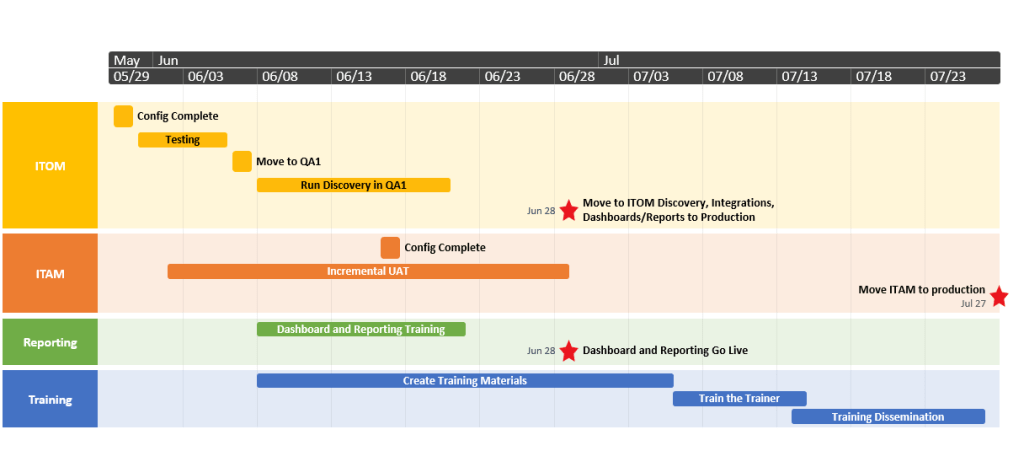Executive Summary
The current go-live window was targeted as a singular go-live for all aspects of this project phase. It has become apparent as we move through the configuration stage that this approach does not provide the best value for us or our stakeholders. We will be moving to a staggered go-live to leverage the technology and workflows in the most effective way.
Background
When this project launched, the goal established by leadership was to have 70% of known servers and end user computers in inventory with 70% of required minimum fields populated for those devices. These two metrics are achieved through two mechanisms: technical (discovery and integrations) and lifecycle workflow processes. These two mechanisms are the two major workstreams of the project: ITOM (CMDB, discovery and integrations) and ITAM (lifecycle workflow and processes).
Current State
The ITOM workstream will be complete and ready for testing a month earlier (late May) than the ITAM workstream (late June). Once this testing is complete in the test environment, it will be ready to move to production by the end of June. Moving this workstream to production to this timeframe greatly assists us in meeting the initial goal of 70% of known servers and end user computers in inventory. This workstream does not require end user training to move to production.
The ITAM workstream will not be completed and ready for testing until mid to late June. After configuration and testing are complete training materials will be created, the train the trainer program will be executed, and time will be allotted for the departmental trainers to disseminate the information to their teams. After these conditions have been satisfied, the workflow/lifecycle/processes for ITAM can go live. This second go-live would be at the end of July.
Rationalization and Risks
This incremental go-live reduces risk by:
- Running Discovery and integrations in production before the lifecycle workflow rolled out gives end users real data to work with to understand the real-world impact of the processes and procedures.
- Delaying rollout of lifecycle workflow allows sufficient time for training and change management. This will help our users more effectively use the system.
- Incremental User Acceptance Testing can reduce risk by bringing forth potential issues sooner in the process so they can be remediated more quickly.
There are risks associated with this approach.
- We will be taking an incremental approach to User Acceptance Testing on the ITAM workstream, which is new to WashU, and may require extra training for our testers. It will also require the testers to be brought in for multiple sessions over a relatively short period of time (4-5 weeks).
- There may be additional costs from our vendor Cask; we are awaiting information from their leadership on this approach.
- This may result in slight delays to launching the next set of projects on the roadmap.
Summary of Dates

May 29th – ITOM configuration complete
June 5th– ITOM testing complete
June 6th– Move ITOM to QA1
June 8th-21st- Dashboard and Reporting Training
June 16th– ITAM configuration complete
June 20th– Complete test run of Discovery and integrations in QA1
June 28th– Move ITOM Discovery, integrations, dashboards/reports to production (begin collecting production statistics/metrics and providing real time dashboards and reports to end users)
June 1-June 28th– Incremental UAT (User Acceptance Testing) for ITAM
July 5th- Training materials finalized
July 7th– 13th– Train the Trainer
July 14th-July 27th– Training dissemination to departments
July 28th– Move ITAM to production